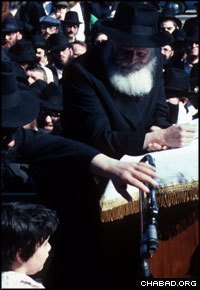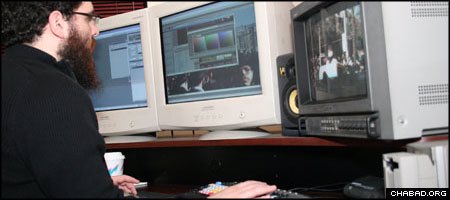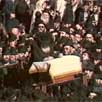With millions of Jewish people worldwide expected to bless G‑d for creating the sun this April 8 in fulfillment of a once-in-a-generation precept, those who are wondering just how it was done 28 years ago are finding their questions more apt than ever.
They need look no further than the newest release from Jewish Educational Media, a 90-minute DVD entitled “Blessing of the Sun.” Built from a stock of professional and amateur film and video, the video’s centerpiece is a presentation of the historic 1981 gathering outside Lubavitch World Headquarters, where men, women and children of all ages looked to the Rebbe, Rabbi Menachem M. Schneerson, of righteous memory, for guidance on how exactly to commemorate the return of the sun to the point it occupied on the very day of its creation.
It also includes an introduction to the ceremony, a background on its sources in rabbinic law, and a talk the Rebbe delivered just days after the 1981 event stressing the importance of developing solar energy as an alternative to traditional fuels.
Yanki Asher, a member of the team of JEM editors that devoted an average of two hours for every minute of the DVD’s production, explained that the effort was aimed not only at showing everyone just how the Rebbe and his followers did it, but to also highlight the blessing’s meaning and significance.
“We want others across the globe,” he said, “to be able to see how the ceremony is performed and to learn the explanations for themselves.”
Starting at 8:15 on a Wednesday morning, the 1981 gathering along Eastern Parkway in the Crown Heights section of Brooklyn, N.Y., was a novelty even among the majority of Chasidim there. Many hadn’t been born before the sun’s last blessing, in 1953, and a good number of those who were around back then, didn’t know about the practice.
But in the weeks leading up the blessing, the Rebbe told his followers around the world to gather as many people as they could for the occasion in their own communities.

In New York, the Rebbe instructed that the ceremony begin with a soul-stirring melody composed by the First Chabad Rebbe, Rabbi Schneur Zalman of Liadi. Traditionally sung only on rare occasions, the inclusion of “The Four Stanzas,” or daled bavot in Hebrew, underscored the momentous nature of the occasion. Afterward, the Rebbe started singing a joyous melody composed by his father, Rabbi Levi Yitzchak Schneersohn, of righteous memory.
Throughout the proceedings, the crowd kept their eyes focused on the Rebbe, paying attention to how he performed the rare service.
JEM’s producers realized that many in their audience will likely approach the video the same way.
“We wanted to keep the entire ceremony without missing any of the moments,” said Asher.
That goal, however, presented a challenge in combining sometimes disjointed footage culled from multiple sources. Some of the material was choppy and out of focus, while whole spans of time went unrecorded by video. In those instances, the editing team resorted to the plethora of still photographs taken that day.
Similar procedures have resulted in a JEM catalog that Dr. Harold Morgan, a gynecologist living in New Jersey, said is impressive.
“They are excellent excerpts that give you a lot of insight,” he said. “They have done an excellent job in producing these films.”

Filming History
A crucial element of the archive JEM drew on for the DVD was the footage taken by Sholom Ber Goldstein, who brought his 8-mm. camera to the 1981 gathering, although he could only film up to three minutes at a time.
Because of the amount of film required, “I couldn’t do the entire event at once,” he said.
Goldstein’s first film was of a 1970 Jewish unity parade outside of Lubavitch World Headquarters, which he made using a borrowed camera. In 1974, after filming his brother’s wedding, he adopted video recording as a hobby, filming weddings as well as the Rebbe and community events in Crown Heights.
But it wasn’t easy for the cameraman, who risked the Rebbe’s displeasure by videotaping him. The Rebbe, at times, expressed disapproval of his Chasidim filming and photographing him. According to Goldstein, the Rebbe preferred that people would spend their time studying Torah instead of remaining behind a camera focused on him.
So when he approached the growing crowd in 1981, Goldstein was apprehensive.
“People did not in anyway want to cause the Rebbe any discomfort,” he explained, “so there was resistance to my filming the Rebbe.”
The man took great pains in being discreet and respectful, keeping in mind the significance of the event.
“I like to preserve history,” he relayed. “My father would film when we were small kids, and showed us those films.”
In turn, “I would sit down and show my kids the films.”
Also videotaping that day was Rabbi Yosef Yitzchak Kazen, or “YY” as he was affectionately known.
“He always had every new gadget,” his wife Rochel said of Kazen’s early video camera and other recording equipment.
In the end, Goldstein, who had a good view, captured just more than 20 minutes of the 50-minute ceremony. Kazen, who stood on the edge of the crowd, recorded much more.
To round out its footage, JEM turned to archived television broadcasts of the event, giving its editors another two minutes of film.
Access to the material was made possible by the Living Archive Restoration & Preservation Project, an ongoing JEM initiative that gathers and preserves the thousands of photographs, films and audio recordings of the Rebbe’s many talks and gatherings. JEM itself was founded the same year as the solar-themed event, with a mission to harness technology to document the Rebbe’s teachings and broadcast them by satellite for the benefit of the public. (The organization’s founder, Rabbi Hillel Dovid Krinsky, married his wife Sori the day before the 1981 gathering.)
In New Jersey, Morgan noted that while its final products are far from pop-entertainment, JEM powerfully presents Jewish history and teachings.
“This is not a Steven Spielberg, but it does not need to be 100 perfect,” said the doctor. The Rebbe’s teachings are “what is significant. It is the subject at hand that is important.”
The Rebbe “was dynamic; his teachings were incredible,” continued Morgan. “The Rebbe was undoubtedly one of the great men of our times.”
JEM director Rabbi Elkanah Shmotkin expressed gratitude for those who picked up their cameras that day.
“Thank G‑d for people like Sholom Ber Goldstein,” he stated. “Because of them, today we are able to piece together the many historic events like the Blessing of the Sun.”
Click here to purchase the Blessing of the Sun DVD.









Start a Discussion